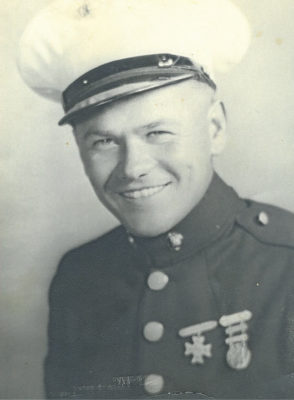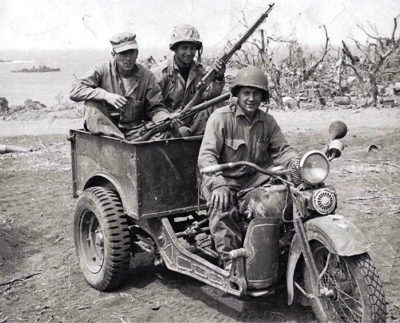Having found a family connection with Iwo Jima in 2016, we are in the midst of an odyssey to discover what happened to Linda’s Father at the Battle of Iwo Jima, between February 19th and March 26th, 1945. We have purchased and devoured forty plus books on Iwo Jima, and the quest continues, but at this 77th anniversary we pause to address another aspect that we inadvertently uncovered, namely the Navy Seabees and Marine Engineers, and two of their construction projects. These projects were the road up Mount Suribachi and the B-29 Runways, each built under the onslaught of mortars, artillery, small arms fire and falling bombs.
Because of the endless slaughter of our Marines by the seemingly limitless Japanese artillery and mortar fire, the few journals and accounts from Murray’s “D” Company 26th Marines are horrifying and shocking. For 36 days Murray’s 2nd Platoon suffered extreme violence, with many bodies blown in half, and a final casualty rate of 98%. 98%!!
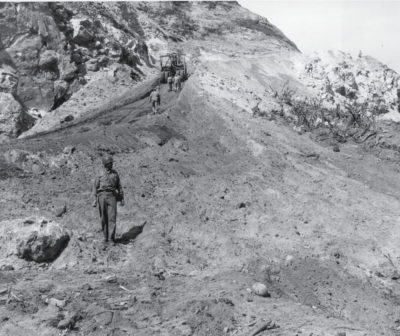
Figure 1: Seabees with the 31st Naval Construction Battalion building the first road on the north side of Mt. Suribachi, Iwo Jima. U.S. NAVAL HISTORY AND HERITAGE COMMAND
The impetus of the first phase of the Suribachi road was to get artillery spotters, flash ranging and echo apparatus to the top. These apparatuses greatly improved the accuracy of the U.S. naval and artillery fire, allowing the Japanese field pieces to be taken under more accurate fire nearly as soon as they fired. Slowly but surely these Japanese pieces were eliminated. Much of this success can be attributed to the building of the first road to the top of Mount Suribachi. Ironically, the secret to the Marines’ ultimate success was in getting the Japanese field pieces and mortars to fire and thus reveal their hidden caves and pillboxes.
The Mystery of the Suribachi Road
Engineering wise, Google Earth Pro images indicate that the Suribachi Road is an engineering nightmare. How can this be, it was built by Navy Seabee 31? However, elevation and grade computations from Google Earth Pro show a wild variation of grades, with grades as steep as 20% and grade breaks at switchbacks as high as 32%

Figure 3: Photograph taken during the service of Ladelle A. Hamilton in the USAAF in the PTO in WWII.
Figure 1 above is of the nascent Suribachi road and shows a Tractor, Heavy, M1 (Cat D7) with a LeTourneau carryall scraper, doing what? It is difficult to load a scrapper going uphill and impossible to load broken rock. What are the seven following men doing? In building a quick and easy road, did NCB31 throw all their skills to the wind?
“Two drivers were shot out of the seat of an unarmored bulldozer that was called up to cut down the…bank. A third engineer volunteer managed to operate the machine by crouching in a sheltered position and manipulating the controls with a shovel and axe handle. By nightfall, the engineers had cleared the way for a tank-led attack. This was combat engineering.” (A Brief history of U, S. Marine Engineers, by Ralph W. Donnelly, page 8.)
Clinton J. Trefethon, 32, (Machinist’s Mate, Third of Kerby, Oregon) …had been operating his heavy bulldozer… “Everything was fine”, he says, Until I started to make a road on D+61, I made one swipe, then backed up in my tracks and went over the same ground again. The second time did the trick. The mine exploded beneath me, blew my helmet off, and knocked a track loose on the dozer.” (Black Hell, page 188.)
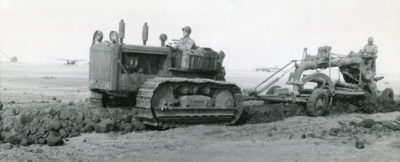 “The massed artillery fires were proving their value, and their accuracy had been greatly increased now by observation posts that had been set up on newly won Mt. Suribachi.” (The Fifth Marine Division in World War II by John C. Chapin, page 11.)
“The massed artillery fires were proving their value, and their accuracy had been greatly increased now by observation posts that had been set up on newly won Mt. Suribachi.” (The Fifth Marine Division in World War II by John C. Chapin, page 11.)
D+5 “Intelligence observers and artillery spotters (including the flash-bang counter-battery observers) soon turned the volcano into a vital observation post.” (The Spearhead by Howard M. Conner, p. 68)
In their rush to get equipment to the top, did the Seabees, in a shell-shocked condition, lose their nerve and just slap-dash the road in?
Second Road
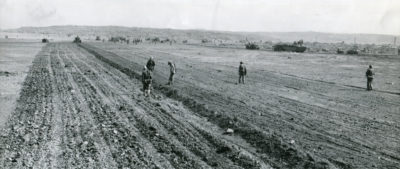
Figure 5 Runway construction showing original surface, scarified surface, and first lift. THAYER SOULE COLLECTION (COLL/2266) AT THE ARCHIVES BRANCH, MARINE CORPS HISTORY DIVISION
This Road was started on D+15 (March 6th.) A wider and more usable road was needed to move the truck-trailer mounted radar, weather and navigational equipment to the top of Mount Suribachi. For all practical purposes, by the time the radar was installed, there was little threat left from Japanese bombers and navy, and the infantry front lines had moved beyond the visible horizon to the north. The purposes of this new equipment would have been to track kamikaze attacks, traffic control our thousand plane B-29 armadas and rescue the crews of downed planes. (History of the U.S. Marine Corps Operations in WWII: Western Pacific Operations, Volume IV, page 611.)
This second Mt Suribachi road was 35 feet wide, had two lanes and was “oiled”. In Figure 2, notice the steady grade and the regular 1.5:1 backslope of this photo, seeming to show that this was not an eyeballed job. However, where are the grade stakes in Figure 2?
Mystery Deepens
 We know from records that the road is 5,000 feet long. The climb is about 400 feet, so a well-designed road should have a grade of less than 10%. However, Jack Cornwell in his A Seabee on Iwo Jima, They Also Served Who Drove Cranes and Cats, reports in mid-1945 that when he went up the road on a borrowed motorcycle he had to use the lowest gear, and the road was so steep that when he came down he also had to use the lowest gear. This sounds like a 20±% grade.
We know from records that the road is 5,000 feet long. The climb is about 400 feet, so a well-designed road should have a grade of less than 10%. However, Jack Cornwell in his A Seabee on Iwo Jima, They Also Served Who Drove Cranes and Cats, reports in mid-1945 that when he went up the road on a borrowed motorcycle he had to use the lowest gear, and the road was so steep that when he came down he also had to use the lowest gear. This sounds like a 20±% grade.
Mystery Begins to Be Solved
1. Mr. Cornwell probably had an underpowered cycle, see the “Mystery Solved” sidebar. 2. As in most non-continental U.S. areas, we should not depend on the terrain mode of Google Earth Pro to determine elevations or grades. For instance, Google shows the top of Mount Suribachi to be 350 feet, but all other sources give it as 550-556 feet above sea level.
Mystery Solved
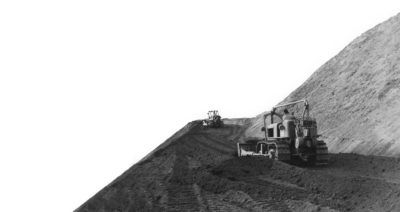
Figure 2: In this image of the construction of the second road to the top of Suribachi, the cats appear to be pushing fill uphill. What? it is always MUCH more effective to build from the top, down. Here the cats are packing a darn good load, so they must be pushing downhill and the image is an optical illusion. NATIONAL ARCHIVES A-70491A.C.
According to Figures 2 and 3, the Suribachi road was well designed and executed, and Google is the one in error. Notice the observation tower on the left and radar equipment on the right.
D+14 “To the south even Suribachi’s face began to change as the 31st Construction Battalion built a road to the summit. Below, in a prisoner stockade, one Japanese officer wept. ‘For twenty years’ he said, ‘we tried to make a road to the top and you did it in two weeks!’” (The Spearhead by Howard M. Conner, p. 67.)
Four B-29 Superfortress Runways

Figure 6 THAYER SOULE COLLECTION (COLL/2266) AT THE ARCHIVES BRANCH, MARINE CORPS HISTORY DIVISION
With Suribachi in the background, the Seabees and Marine Engineers prepared the runways with even greater care. At the 10,000-foot Motoyama Runway, more than 3 million yards of earth was moved. Based upon four high resolution photographs and a 14-minute movie, the Seabees and Engineers reconditioned and extended the runways as follows:
- A Caterpillar D-7 scarified the existing surface, turning up mines, duds and large pieces of shrapnel, which were then disposed of.
- Another mystery. “Gunk is being trucked in and dumped in windrows the full length of the runway. It does not contain rock or coral, just lumps of gunk. What is gunk?
- A road grader then worked the windrows, which readily broke up the large clumps of gunk.
- A demolition squad scours the fill for duds, land mines and large pieces of shrapnel, another mystery solved.
- The 4”± lift of sand-clay was then spread evenly. Mystery Solved! On pages 200-201 of Lt. Col. Whitman S. Bartley USMC’s tome: History of Iwo Jima: Amphibious Epic: “Quarries yielded excellent sand-clay fill that greatly facilitated the construction of roads. This material required little mechanical stabilization, and a daily motor patrol, shaping and filling were necessary and sprinkling with water sufficed to keep the roads in usable condition. This same material was also used in the rehabilitation and extension of Airfield Number 1 and made possible the early completion of (other runways).” Is the sand-clay something like crumbly decomposed granite, which is an igneous granite with sodium instead of potassium?
- Seawater was used to bind the fill. The sand-clay was then rolled. (350,000 gallons of seawater was used per day to bind fill.)
- Such lifts were brought in until they matched the grade stakes. (One grade stake can be seen in Figure 6).
- When the desired depth of sub-base was obtained the runway was then paved.
 To quote Ivan Thunder from the book Black Hell, the Story of the 133rd Navy Seabees at Iwo Jima: “The Japs got in the first lick. They ambushed the Eighth’s survey party and killed C.A. Van Eps (Carpenter’s mate Third, Callender IA) and wounded E.F. Young (Machinist’s Mate First, Toledo OH) and F.C. McGowan (Chief Shipfitter, Jacksonville FL) … (It was thereafter common) for a four-man surveying team to be escorted by as many as a dozen extra Seabees, just for protection against snipers. One quick-thinking power-shovel operator swung his bucket around and filled the mouth of two caves in a hurry when sniper’s bullets began bouncing off his cab.” pages 74 & 89.
To quote Ivan Thunder from the book Black Hell, the Story of the 133rd Navy Seabees at Iwo Jima: “The Japs got in the first lick. They ambushed the Eighth’s survey party and killed C.A. Van Eps (Carpenter’s mate Third, Callender IA) and wounded E.F. Young (Machinist’s Mate First, Toledo OH) and F.C. McGowan (Chief Shipfitter, Jacksonville FL) … (It was thereafter common) for a four-man surveying team to be escorted by as many as a dozen extra Seabees, just for protection against snipers. One quick-thinking power-shovel operator swung his bucket around and filled the mouth of two caves in a hurry when sniper’s bullets began bouncing off his cab.” pages 74 & 89.
“…Lieutenant Sam Stanbery (Headquarters Company Commander) and a crew were out surveying… The Rodman went ahead and a man with a carbine, at the ready, guarded him. Sam and a few men were at the plane table. A Jap stood up in a small gully and looked at the Rodman. The guard swung around and was about to shoot the Jap when the Rodman said, “Don’t shoot him.” So, they took him prisoner…A few days before, Sam had driven over a Jap mine, and had the rear end of his Jeep blown off. It scared the hell out of him, and he was in no mood to take any Jap prisoner, but they did… The Chief Master at Arms and two MAs and the prisoner, drove all over…to show off the prisoner we had captured. I know they hailed me down on the road to show me.” Black Hell, page 124.
Conclusion
On Iwo Jima the NCB133 suffered their own high casualty rate of 43%. However, many children, grandchildren and now great grandchildren owe their existence to the sacrifices made by the Seabees and Marine Engineers, without them, we would not be. “Greater love hath no man than this, that a man lay down his life for his friends,” John 15:13. “…love covers over a multitude of sins”, I Peter 4:8.
Chad Erickson has been licensed as a PLS in multiple states since 1985 and he and his wife Linda have been published in The American Surveyor 17 times.
1 Time was kept from the departure date (D Day). At Iwo Jima D Day was February 19, 1945, thus D+6 was February 25th.
Three servicemen on Iwo Jima on April 16, 1945, showing off their war souvenirs, two Arisaka rifles and a delivery vehicle adopted by the Japanese military and repaired by G.I.s. The delivery car might have been a little underpowered but still, it was a Harley. Is this the cycle borrowed by Jack Cromwell? In our research we found no mention of G.I. motorcycles on Iwo Jima or any other island in the Pacific.
—A Seabee on Iwo Jima: They also served who drove cranes and cats.
WWII Magazine, 19th Paragraph. By Jack Cornwell
“When I went back to work (as a crane operator digging out Japanese caves), I hit a bonanza—a box about the size of a footlocker, full of 10-yen notes. One of those went for a buck. I borrowed a jeep, loaded it with scrip, and drove to where the pilots and mechanics had their tents. I came back with $150 cash, two bottles of champagne, and 13 eggs, plus souvenirs I could trade. I had to give the jeep back, plus a bottle of champagne for the use of it, but then the guy let me have a motorcycle with a sidecar. Off I went with a load of souvenirs. After I sold them I decided to go to Suribachi. By then the 31st Seabees had built an oiled road to the top; it was so steep I had to go in low gear. At the top I looked into the volcano and at lots of caves and the battleships and cruisers offshore. I didn’t see the famous flag, whether because it had been taken down or I just wasn’t looking in the right place. Coming down was as bad as going up, low gear all the way, but I returned the motorcycle in one piece. Nobody else in my unit ever got up there.”
Saipan Hardball
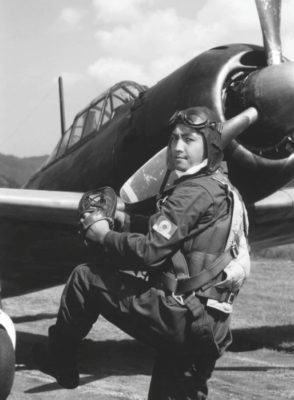 “On Saipan, working at the runway at the North Field near the edge of the jungle, one morning some of the engineers were startled to discover two Japs sitting astride the fence bordering the field. The Japs, tattered from months of hiding in the jungle, were having a helluva time sidewalk superintending the construction job. They dropped from the fence and scampered off through the jungle when one of the men on a bulldozer reached for his rifle.
“On Saipan, working at the runway at the North Field near the edge of the jungle, one morning some of the engineers were startled to discover two Japs sitting astride the fence bordering the field. The Japs, tattered from months of hiding in the jungle, were having a helluva time sidewalk superintending the construction job. They dropped from the fence and scampered off through the jungle when one of the men on a bulldozer reached for his rifle.
On the following day, the Japs were back, boldly hanging over the fence with the same fascination people in large cities have for excavating projects. And the engineers, quite pleased to be working for an appreciative audience, kept an eye on them but permitted them to remain.
The Nips, who must have had their own two-man reveille, showed up promptly each morning and stayed throughout most of the day—evidently enjoying the show hugely. It got to a point that the engineers felt a little lonely when their audience would suddenly disappear into the jungle.
The thought that the Japs might have deserted them to watch the Seabees was too horrible to contemplate, so they think their fans were captured or killed and were always a little bitter about it.
—One Damned Island After Another
by Clive Howard and Joe Whitley, pages 241-242.
• • • • •
“Another of the favorite sagas was of the Jap who was a rabid baseball fan. (By 1898 baseball was nationally popular in Japan). This Jap turned out for every game played by one engineering squadron and sat on a bare hill overlooking the diamond, alternately cheering the engineers and raising hell with the umpires. Whenever a decision went against the engineers, the Jap would jump up and scream something which, roughly translated, seemed to mean ‘Kill the blankety-blank so-and-so.’
One day the engineers were playing the Seabees and the game was going on inning after inning with the score tied. Finally, an engineer caught a Seabee curve squarely and blasted it down the left field foul line. The umpire took one squint and then called the runner back—foul ball!
This was too much for the… Jap. He jumped to his feet, screaming curses in Japanese, and grabbed a piece of coral. Winding up like a sandlot pitcher, he beaned the umpire and then took off over the hill, followed only by the cheers of the engineer rooting section.
Later a Marine patrol—which the engineers vow was egged on by the Seabees—shot the Jap.”
—One Damned Island, pages 242-243
